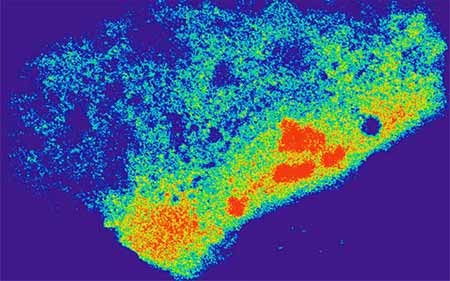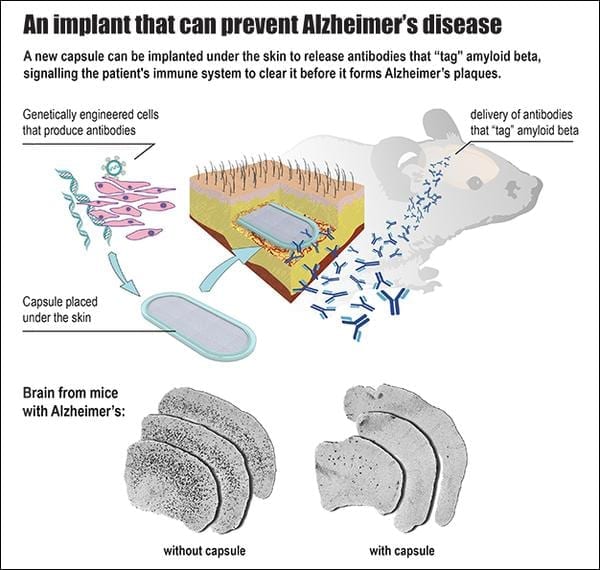
Johns Hopkins Medicine
Glucose derivative in nerve cells may drive satiety
While researching the brain’s learning and memory system, scientists at Johns Hopkins say they stumbled upon a new type of nerve cell that seems to control feeding behaviors in mice. The finding, they report, adds significant detail to the way brains tell animals when to stop eating and, if confirmed in humans, could lead to new tools for fighting obesity.
Details of the study will be published by the journal Science on March 18.
“When the type of brain cell we discovered fires and sends off signals, our laboratory mice stop eating soon after,” says Richard Huganir, Ph.D., director of the Department of Neuroscience at the Johns Hopkins University School of Medicine. “The signals seem to tell the mice they’ve had enough.”
Huganir says his team’s discovery grew out of studies of the proteins that strengthen and weaken the intersections, or synapses, between brain cells. These are an important target of research because synapse strength, particularly among cells in the hippocampus and cortex of the brain, is important in learning and memory.
In a search for details about synapse strength, Huganir and graduate student Olof Lagerlöf, M.D., focused on the enzyme OGT — a biological catalyst involved in many bodily functions, including insulin use and sugar chemistry. The enzyme’s job is to add a molecule called N-acetylglucosamine (GlcNAc), a derivative of glucose, to proteins, a phenomenon first discovered in 1984 by Gerald Hart, Ph.D., director of the Johns Hopkins University School of Medicine’s Department of Biological Chemistry and co-leader of the current study. By adding GlcNAc molecules, OGT alters the proteins’ behavior.
To learn about OGT’s role in the brain, Lagerlöf deleted the gene that codes for it from the primary nerve cells of the hippocampus and cortex in adult mice. Even before he looked directly at the impact of the deletion in the rodents’ brains, Lagerlöf reports, he noticed that the mice doubled in weight in just three weeks. It turned out that fat buildup, not muscle mass, was responsible.
When the team monitored the feeding patterns of the mice, they found that those missing OGT ate the same number of meals — on average, 18 a day — as their normal littermates but tarried over the food longer and ate more calories at each meal. When their food intake was restricted to that of a normal lab diet, they no longer gained extra weight, suggesting that the absence of OGT interfered with the animals’ ability to sense when they were full.
“These mice don’t understand that they’ve had enough food, so they keep eating,” says Lagerlöf.
Because the hippocampus and cortex are not known to directly regulate feeding behaviors in rodents or other mammals, the researchers looked for changes elsewhere in the brain, particularly in the hypothalamus, which is known to control body temperature, feeding, sleep and metabolism. There, they found OGT missing from a small subset of nerve cells within a cluster of neurons called the paraventricular nucleus.
Lagerlöf says these cells already were known to send and receive multiple signals related to appetite and food intake. When he looked for changes in the levels of those factors that might be traced to the absence of OGT, he found that most of them were not affected, and the activity of the appetite signals that many other research groups have focused on didn’t seem to be causing the weight gain, he adds.
Next, the team examined the chemical and biological activity of the OGT-negative cells. By measuring the background electrical activity in nonfiring brain cells, the researchers estimated the number of incoming synapses on the cells and found that they were three times as few, compared to normal cells.
“That result suggests that, in these cells, OGT helps maintain synapses,” says Huganir. “The number of synapses on these cells was so low that they probably aren’t receiving enough input to fire. In turn, that suggests that these cells are responsible for sending the message to stop eating.”
To verify this idea, the researchers genetically manipulated the cells in the paraventricular nucleus so that they would add blue light-sensitive proteins to their membranes. When they stimulated the cells with a beam of blue light, the cells fired and sent signals to other parts of the brain, and the mice decreased the amount they ate in a day by about 25 percent.
Finally, because glucose is needed to produce GlcNAc, they thought that glucose levels, which increase after meals, might affect the activity of OGT. Indeed, they found that if they added glucose to nerve cells in petri dishes, the level of proteins with the GlcNAc addition increased in proportion to the amount of glucose in the dishes. And when they looked at cells in the paraventricular nucleus of mice that hadn’t eaten in a while, they saw low levels of GlcNAc-decorated proteins.
“There are still many things about this system that we don’t know,” says Lagerlöf, “but we think that glucose works with OGT in these cells to control ‘portion size’ for the mice. We believe we have found a new receiver of information that directly affects brain activity and feeding behavior, and if our findings bear out in other animals, including people, they may advance the search for drugs or other means of controlling appetites.”
Learn more: Portion Control: Cells Found in Mouse Brain That Signal ‘Stop Eating’
The Latest on: Enyme OGT
[google_news title=”” keyword=”enyme OGT” num_posts=”10″ blurb_length=”0″ show_thumb=”left”]
via Google News
The Latest on: Enyme OGT
- Liver Enzymes and Risk of All-Cause Mortality in General Populations: A Systematic Review and Meta-analysison May 6, 2024 at 4:59 pm
Background Gamma glutamyltransferase (GGT), alanine aminotransferase (ALT), aspartate aminotransferase (AST) and alkaline phosphatase (ALP), commonly used as markers of liver dysfunction, have ...
- MyEG, OGT in electric bike tie-upon May 4, 2024 at 5:00 pm
PETALING JAYA: MyEG Services Bhd has inked a memorandum of understanding (MoU) with Oyika Green Technologies Sdn Bhd (OGT) to collaborate on the use of electric motorcycles and placement of ...
- 5 Ways to Use Papainon April 30, 2024 at 5:00 pm
Papain is an enzyme found in papaya, but it’s also available in other forms. Limited research suggests it may offer some health benefits, like improved digestion. Papain is a proteolytic enzyme ...
- Top 5 Best Enzyme Supplements in 2024on April 23, 2024 at 5:00 pm
The overall well-being of our body is heavily reliant on enzymes. These vital components transform food into nutrients that our body can use. Nonetheless, there might be individuals who naturally ...
- What to know about cardiac enzymes (cardiac biomarkers)on April 21, 2024 at 5:00 pm
Elevated cardiac enzyme levels indicate when someone has experienced a heart attack. A cardiac enzyme test can measure the amount of cardiac enzymes in a person’s blood. Certain enzymes are ...
- Top 9 Best Digestive Enzyme Supplements in 2024on April 16, 2024 at 5:01 pm
The importance of a healthy gut for overall well-being cannot be overstated, made evident by the rising popularity of digestive enzyme supplements. These supplements include a critical mix of ...
- Serrapeptase: The Enzyme That Can Relieve Almost All Pain And Inflammation When Used This Wayon March 16, 2024 at 7:14 am
Serrapeptase is a protein enzyme that is extracted from the digestive system of the silkworm, which uses that enzyme to break down its cocoon. In the U.S., serrapeptase is used as a dietary ...
- Enzymes: Moving at the Speed of Lifeon January 13, 2023 at 7:10 pm
How does your body speed up these important reactions? The answer is enzymes. Enzymes in our bodies are catalysts that speed up reactions by helping to lower the activation energy needed to start a ...
- Digestive enzymes and absorptionon August 10, 2021 at 9:08 am
Enzymes are biological catalysts which speed up reactions including digestion. VOICEOVER: Enzymes of the digestive system. Three key types of enzymes in different parts of our digestive system ...
- Digestive enzymes and absorptionon August 10, 2021 at 9:05 am
Enzymes are biological catalysts which speed up reactions including digestion. VOICEOVER: Enzymes of the digestive system. Three key types of enzymes in different parts of our digestive system ...
via Bing News










